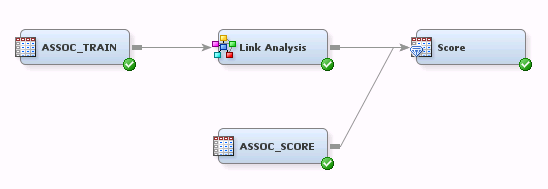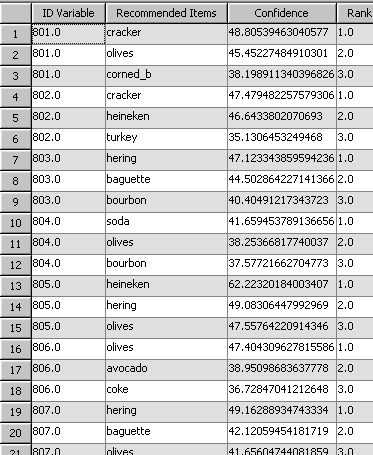- Home
- /
- SAS Communities Library
- /
- Tip: Making Recommendations Using SAS® Enterprise Miner™ Link Analysis...
- RSS Feed
- Mark as New
- Mark as Read
- Bookmark
- Subscribe
- Printer Friendly Page
- Report Inappropriate Content
Tip: Making Recommendations Using SAS® Enterprise Miner™ Link Analysis Node
- Article History
- RSS Feed
- Mark as New
- Mark as Read
- Bookmark
- Subscribe
- Printer Friendly Page
- Report Inappropriate Content
The Link Analysis node in SAS Enterprise Miner can make recommendations to customers based on their transactional history data by providing a next-best-offer list.
In this tip, I’ll cite an example to demonstrate how to use the Link Analysis node to get next-best-offer list for transactional data. If you are interested in how the Link Analysis node generates the next-best-offer list, refer to the paper, Link Analysis Using SAS® Enterprise Miner™, for details.
Example
The example data set in this example is modified from data SAMPSIO. ASSOCS (stored in the sample library) contains 7,007 separate customer transactions. CUSTOMER is an ID variable that identifies the customers. PRODUCT is the nominal target variable.
We use the first 801 customers’ transaction data as the training data, and use the rest of the data as the data to be scored.
data assoc_train;
set sampsio.assocs(where=(customer le 800));
run;
data assoc_score;
set sampsio.assocs(where=(customer gt 800));
run;
Create a flow like the one in Display 1:

Display 1. Link Analysis Flow
First, use the following steps to configure the flow:
- Set the role of data assoc_train to Transaction, and set the role of data aasoc_score to Score.
- Set the variable roles for both data as follows:
Right-click on each Ids (input data set) node and select Edit Variables. Assign the roles as shown in Display 2.

Display 2. Variable Roles
3. Adjust the Score property of Link Analysis to get next-best-offer list. If you set Generate Recommendation Table to Yes (the default setting) in the Score property window, the next-best-offer list is displayed in the score output. You can export the full recommendation table, or the filtered recommendation table that results from specifying properties such as “Top N,” “Minimum Confidence (%),” and “Criterion Relation,” as shown in Display 3.

Display 3. Recommendation Table Properties Window
4. Leave all other properties in the nodes of the flow as default, run the flow.

Display 4. Filtered Recommendation Table for Training Data
If you specify the settings shown in Display 3, a filtered recommendation table is displayed in Link Analysis node’s Results window, as shown in Display 4. The table contains the top three next-best offers for each of the customer ID from 0 to 800.
Now click on the Score node, and go to the property panel of it, as shown in Display 5.
Click … to open the exported score data in the Score node, you will find the top-3 next-best-offers for customer ID from 801 to 1000, as shown in Display 6. For example, cracker, olives and corned beef are recommended for customer 801.

Display 5. Score Code Property Panel

Display 6. Filtered Recommendation Table for Score Data
April 27 – 30 | Gaylord Texan | Grapevine, Texas
Registration is open
Walk in ready to learn. Walk out ready to deliver. This is the data and AI conference you can't afford to miss.
Register now and save with the early bird rate—just $795!
SAS AI and Machine Learning Courses
The rapid growth of AI technologies is driving an AI skills gap and demand for AI talent. Ready to grow your AI literacy? SAS offers free ways to get started for beginners, business leaders, and analytics professionals of all skill levels. Your future self will thank you.
- Find more articles tagged with:
- enterprise_miner
